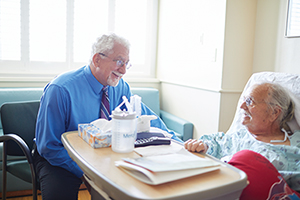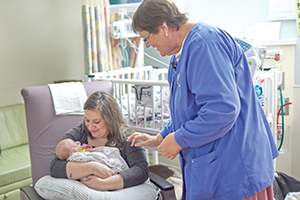By KIM VAN OOSTEN
CHA, in partnership with the National Association of Catholic Chaplains, is surveying spiritual care providers this month and next to inform the ministry's ongoing efforts to attract and groom the next generation of mission and pastoral care professionals and make sure they have the tools and training to do their jobs.
The majority of mission leaders and pastoral care providers in Catholic health care are over age 60, so succession planning in these fields is a priority.
"The goal of the survey is to gather information necessary for the succession planning of this critical role within Catholic health care," said Brian Smith, CHA's senior director of mission integration and leadership formation.

Carl Germain, a Catholic chaplain and deacon, visits R. Alan Buehre at Mercy Hospital Saint Louis. Germain, a chaplain for 13 years, is one of the 2,000 spiritual care providers CHA and NACC will survey in September to get a snapshot of chaplaincy today. Chris Ryan/© CHA
"In addition, the survey will help us learn where systems and facilities are utilizing spiritual care providers such as in acute care, post-acute care, clinics, home health and virtual visits," Smith said. "Having trained, qualified spiritual care providers in all care settings is essential both to maintaining Catholic identity and to the ministry's commitment to caring for the body, mind and spirit of all patients."
Survey responses will provide insight into how the shift in care delivery from acute to outpatient care impacts the delivery of pastoral care services.
Recruitment, formation, retention
The Center for Applied Research in the Apostolate, a Georgetown University affiliated research center, built the survey tool for CHA and NACC and will send it out by email the week of Sept. 17 to 2,000 chaplains and professional mission leaders who oversee the spiritual care function for their organization as indicated in the CHA and NACC databases. Smith said the center will collect the data between mid-September and the end of October. The research center will analyze the results and researchers will give an initial briefing to CHA's Pastoral Care Advisory Committee in mid-November. Results of the spiritual care survey will be shared with CHA and NACC members early next year.
In addition, NACC and CHA will use the results to shape broader succession planning strategies. For instance, CHA's mission services department will use this data along with other information being collected to develop a tactical plan for the wider ministry to address the recruitment, formation and retention of mission leaders, chaplains and ethicists, Smith said.
He said the research center has over 40 years of experience constructing surveys and other data tools for the Catholic Church in the United States. Its clients include the United States Conference of Catholic Bishops, local dioceses, the National Catholic Educational Association and many other sponsored ministries of the church.

Louise Eggen, a Catholic chaplain for 28 years, visits Emily Conley and her son Beau in the neonatal intensive care unit at Mercy Hospital Saint Louis. Beau was born prematurely and has spent several months as a NICU patient.
Chris Ryan/© CHA
CHA and the NACC have conducted joint surveys of mission and chaplaincy professionals every decade since 1998, and many questions asked in prior surveys will appear in this year's version, along with new ones. This is the first CHA/NACC chaplaincy survey designed by the Center for Applied Research in the Apostolate. Smith said comparisons of the survey findings from prior years could give a better picture of trend lines and point to the tools and competencies that will be of growing importance for mission and chaplaincy professionals in the future.
Adapting with the times
Rose Shandrow, senior vice president of mission integration at CHI Franciscan Health in Tacoma, Wash., is a member of CHA's Pastoral Care Advisory Committee. That committee helped fine-tune the survey questions. She said survey responses will be compared to prior research involving chief executives, chief nursing officers and chief medical officers to assess whether those health care leaders and chaplains have a shared view of the function and contributions of chaplaincy across health care settings. Survey results also will be used to help identify what type of professional development training will best prepare mission and spiritual care providers to adapt to changes in health care delivery.
Jennifer Cobb, executive director of Mercy mission and spiritual care at Mercy's system headquarters in Chesterfield, Mo., also is a member of CHA's Pastoral Care Advisory Committee.
"Chaplaincy is evolving to care for the patient outside the institutional walls," Cobb said. Like their clinician counterparts, chaplains are making greater use of communications technology and making patient-centered care a priority.
She explained that a spiritual care provider may take part in a meeting between patient and doctor in order to facilitate a conversation to clarify the patient's values and goals of treatment. These conversations are especially important in setting goals of care at the end of life. Spiritual care providers might contact patients by phone after they leave the hospital to provide continuing pastoral care. They may meet a patient in a video consult, where they assess spiritual needs, provide pastoral care and suggest resources. Some pastoral care providers make house calls or meet with patients at the local coffee shop for a consult.
"The recipients of our care in the future will be defined by their needs, not their locations. Because challenging health issues are a leading cause of spiritual distress, spiritual care should be available wherever they encounter our health care systems. The opportunity is simply beautiful," Cobb said.
Workplace spirituality
David Lichter, executive director of NACC, said the survey will help leaders in mission and spiritual care assess and articulate how spiritual care improves patients' experience and sense of well-being, and how it assists patients with serious illness in clarifying how their goals for care relate to medical decision-making.
"Results of this 2018 effort can hopefully also assist in spiritual care being viewed as an essential service and embraced by executives who are making decisions about investing in spiritual care as vital to the future of Catholic health care," said Lichter.
Shandrow said the case for chaplaincy also should take into account the central role chaplains play in cultivating spirituality in the workplace and caring for the caregivers — topics that will be addressed in the survey.
"They facilitate debriefings and provide emotional support to clinicians who have encountered difficult and challenging cases. They serve as educators by providing various in-service trainings for clinicians on spiritual care. They collaborate with leaders in key service lines by offering suggestions for improving the patient experience based on their patient encounters," Shandrow said. "Furthermore, they develop opportunities to further the desired culture of the organization by aligning their activities with mission integration endeavors."
Smith said the survey will be sent to spiritual care providers who work within Catholic health care. In addition to board-certified chaplains, the survey will be sent to those in CHA's and NACC's databases who have a spiritual care function. This might be a chaplain with some clinical pastoral education training or a trained spiritual care volunteer. The survey will include a section for the person who oversees the day-to-day operations of the pastoral care department within the facility or region — such as the lead chaplain, mission leader or director of spiritual care.
Copyright © 2018 by the Catholic Health Association
of the United States
For reprint permission, contact Betty Crosby or call (314) 253-3490.